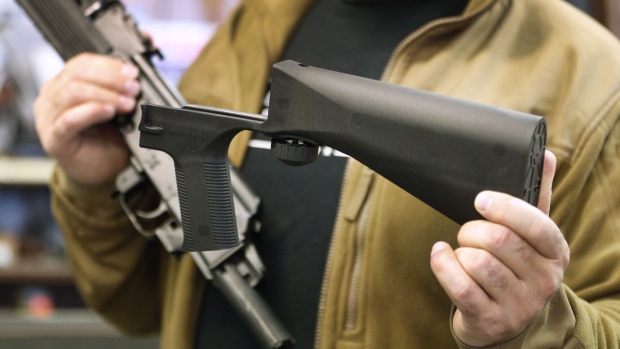Jun 14, 2024
Bump Stock Ban Tossed Out by Supreme Court in Gun-Rights Win
, Bloomberg News

(Bloomberg) -- A divided US Supreme Court threw out the federal ban on bump stocks, saying regulators exceeded their power by outlawing the rapid-fire devices after they were used in the deadliest mass shooting in the country’s history.
Voting 6-3 along ideological lines, the justices voided a criminal prohibition put in place by the Trump administration after the 2017 Las Vegas concert massacre, when a man using bump stocks killed 60 people. Bump stocks let a semiautomatic rifle fire at speeds rivaling a machine gun.
Writing for the court, Justice Clarence Thomas said rifles equipped with bump stocks nonetheless don’t meet the legal definition of a machine gun, which are outlawed under a 1986 law.
“A bump stock does not convert a semiautomatic rifle into a machine gun any more than a shooter with a lightning-fast trigger finger does,” Thomas wrote.
Justices Sonia Sotomayor, Elena Kagan and Ketanji Brown Jackson dissented, with Sotomayor reading a summary of her opinion from the bench for emphasis.
“The majority’s artificially narrow definition hamstrings the government’s efforts to keep machine guns from gunmen like the Las Vegas shooter,” Sotomayor wrote for the group. She said the ruling will have “deadly consequences.”
The ruling means that a ban on bump stocks would require an act of Congress — something President Joe Biden urged on Friday.
“Congress must ban bump stocks, pass an assault weapon ban, and take additional action to save lives,” Biden said in a post on X. “Send a bill to my desk. I will sign it immediately.”
Shooting Reaction
Once familiar only to gun enthusiasts, bump stocks became a national focus after the Las Vegas shooting. Five months after the shooting, then-President Donald Trump told the Bureau of Alcohol, Tobacco, Firearms and Explosives to come up with a way to ban the devices.
ATF, which is part of the Justice Department, then issued a rule classifying rifles with bump stocks as machine guns, reversing a position the bureau had taken previously.
The ban was a rare example of a Republican administration signing off on a gun-control measure. But the ban also eased pressure on Republican members of Congress who otherwise would have faced demands to pass legislation that would have angered donors like the National Rifle Association.
At the time of the 2018 rule, ATF estimated that more than 500,000 bump stocks had been manufactured over the previous eight years. The Supreme Court let the ban take effect in 2019.
The fight concerned the reach of a federal statute rather than the Second Amendment, the constitutional provision the court has used to expand gun rights in recent years. The court is also scheduled to rule in the coming weeks in a constitutional clash over the federal gun ban for people subject to domestic-violence restraining orders.
Bump Stocks
Supporters of the ban included Everytown for Gun Safety, which is backed by Michael Bloomberg, founder and majority owner of Bloomberg LP.
“Guns outfitted with bump stocks fire like machine guns, they kill like machine guns, and they should be banned like machine guns — but the Supreme Court just decided to put these deadly devices back on the market,” said John Feinblatt, president of Everytown, which urged Congress to pass bipartisan legislation banning the devices.
Douglas Letter, chief legal officer of the Brady Center to Prevent Gun Violence, said the ruling means “more people are going to die.”
The National Rifle Association cheered the decision.
“The Supreme Court has properly restrained executive branch agencies to their role of enforcing, and not making, the law,” said Randy Kozuch, executive director of the group’s lobbying arm. “This decision will be pivotal to NRA’s future challenges of ATF regulations.”
Bump stocks replace the standard stock on a rifle — the part that rests against the shooter’s shoulder — with a plastic casing that lets the weapon slide forward and backward. The device harnesses the recoil energy when a shot is fired, causing the gun to slide backward and separate from the trigger finger. The separation lets the firing mechanism reset.
By applying constant forward pressure with the non-trigger hand, the shooter can then force the rifle forward so that it “bumps” the trigger finger, even without moving the finger.
At issue was whether bump stocks meet the law’s definition of machine guns as weapons that can “automatically” discharge more than one shot “by a single function of the trigger.” Thomas said said that language, first used in a 1934 law that required registration of machine guns, can’t apply to bump stocks.
“Between every shot, the shooter must release pressure from the trigger and allow it to reset before reengaging the trigger for another shot,” Thomas wrote. “A bump stock merely reduces the amount of time that elapses between separate ‘functions’ of the trigger.”
His opinion included several black and white illustrations of the various stages of a trigger being operated.
Sotomayor countered that the phrase means “a single action by the shooter to initiate a firing sequence, including pulling a trigger and pushing forward on a bump-stock-equipped semiautomatic rifle.”
In a concurring opinion, Justice Samuel Alito said that “Congress can amend the law — and perhaps would have done so already if ATF had stuck with its earlier interpretation.”
The case is Garland v. Cargill, 22-976.
--With assistance from Erik Larson.
(Updates with Biden reaction in eighth paragraph.)
©2024 Bloomberg L.P.








